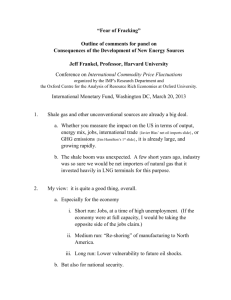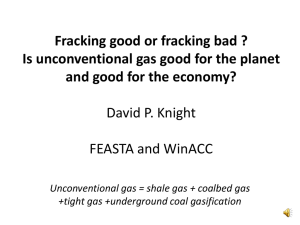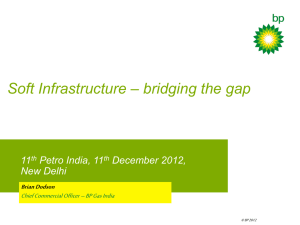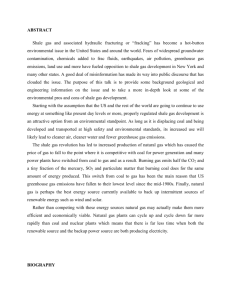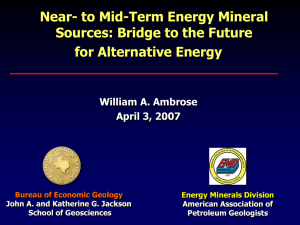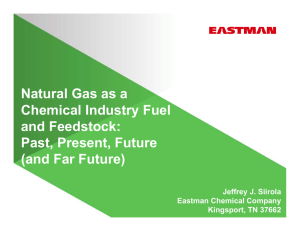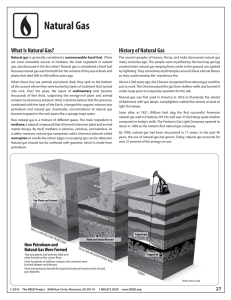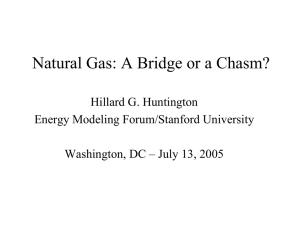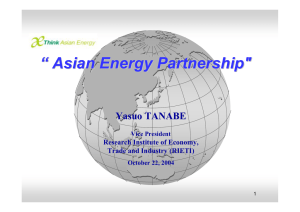F u t u r e ’ s
advertisement
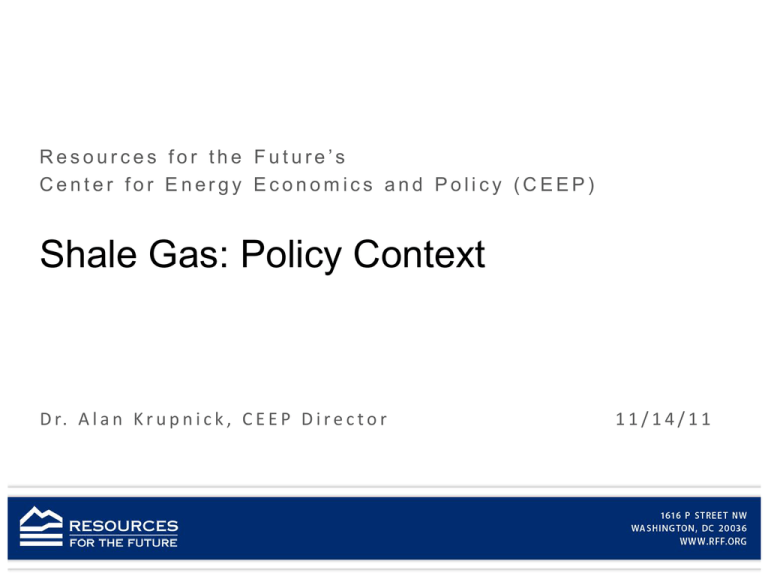
Resources for the Future’s Center for Energy Economics and Policy (CEEP) Shale Gas: Policy Context D r. A l a n K r u p n i c k , C E E P D i r e c t o r 11/14/11 4 4 Costs versus production Production rate Shale gas plays Conventional gas plays Gas price for given rate of return Bulls vs. Bears • Resource Base: “Enough gas for 100 years” vs. “USGS: 80% lower than EIA estimate of resources” • Price: Stable and low vs. BAU • Global warming: “Foundational” vs. “Flimsy bridge to a low carbon future” • Energy Security: “an answer” vs. BAU • Environmental risk: “Tempest in a teapot” vs. fracking bans Marcellus Natural Gas Resource Base (Old Diagram) Discovered? USGS 2011 Estimate 84 tcf Economic? AEO 2011 410 tcf 3 Ps + cumulative production? Marcellus Shale Gas Resource Base (New Diagram) Unproved and Undiscovered Technically Recoverable Resources and Inferred Reserves are essentially measuring the same thing when considering continuous resources. But using different methods and data Whatever the true resource base, • Companies are learning fast – Longer “laterals” (from 2000’ to 8000’) – Faster drilling (from 80 to 20 days) • And being surprised – Shallower decline curves (“decades”) • Two years ago: 4.1 Bcf per well • Today, some wells up to 7.1 Bcf 2 2011 2012 2013 2014 2015 2016 2017 2018 2019 2020 2021 2022 2023 2024 2025 2026 2027 2028 2029 2030 2031 2032 2033 2034 2035 2009 Dollars per million Btu 10 Natural Gas Henry Hub Spot Price Forecasts 9 8 7 6 5 4 3 AEO 2011 AEO 2009 Low and stable for long-run (based on AEO2011). Short-run? Natural gas and global warming • Is natural gas (from shale) a lower carbon substitute for coal? – Fugitive methane*GWP + other fuel cycle elements < > Coal emissions (CO2e) • Will natural gas substitute for coal in the power sector? EIA-ICF (2011) Lifecycle CO2e Analysis Shows Gas (with fracking): 50% Cleaner than Coal Gas still 48% cleaner than coal Lifecycle GHG Emissions (kg CO2e/MWh) 1,200 1,000 1,096 +10% Revision 800 600 566 516 400 200 0 Gas 2010 Gas 2011 Coal Note: 100 year global warming potential Source: EIA, ICF International, DBCCA analysis 2011 13 CMU study: shale gas ~40% cleaner than coal 14 Cornell Study and Critique • GWP => 20 vs. 100 years should stimulate further study • Fugitive methane data are thin (handful of wells in 5 plays). For key play (Haynesville): 15 Methane “emitted” during flow-back thousands of cubic meters 8,000 7,000 6,000 5,000 4,000 3,000 2,000 1,000 0 Haynesville Barnett Piceance Uinta Den-Jules Cornell Study and Critique • GWP => 20 vs. 100 years; IPCC or revised estimates should stimulate further study • Fugitive methane data are thin (handful of wells in 5 plays). For key play (Haynesville): • Documentation misread (IHS Global, 2011) • Methane is mostly flared, rather than vented. Some methane too expensive to capture; • Metering errors can lead to misclassification as fugitive • Research on-going 17 Natural Gas, Power Sector and CO2 emissions • Increased gas resources: – NEMS: AEO2009 269 vs. PGC 616 tcf: increased natural gas use and share, more carbon – HAIKU: AEO2010 347 vs. AEO11 827 tcf: increased gas use and share, slightly less carbon • With CO2 policy: cheap gas lowers costs A “narrow” bridge to a low carbon future, but pressure on old coal plants to retire will likely create a bigger role for natural gas Energy security and global warming: Heavy-duty LNG-Fueled Trucks instead of Diesel Trucks If: – LNG truck is $70K more expensive than diesel – LNG is $1.50/ge cheaper – Observed impatience (31% interest rate) – 125,000 miles/yr. – 5.1 mpge 3 year payback But chicken and egg problem with investment New Investment in LNG Infrastructure • Chesapeake Energy: investing $150 million in Clean Energy Fuels Corp. to develop up to 150 LNG truck fueling stations along major truck corridors (interstates) in the U.S. • 79 stations over the next 2 years; 250 miles apart • Clean Energy partnering with Pilot Flying J • Capacity of system: 3-4 million gallons of LNG/station a year 11K trucks (@125K miles/yr) December 2012 Projected (Chesapeake Energy website) - Niche market for LNG-fueled heavy-duty trucks - Tougher case for CNG-fueled light-duty vehicles; Weak energy security benefits for now Environmental Risk? Aubrey McClendon interview with Forbes: F: It’s clear that as long as wells are cased and cemented properly, fracking is safe, right? M: 100%! Environmental Risk? • No comprehensive analysis of impact pathways • No comprehensive examination of expert opinion • No examination of public opinion where trade-offs are forced – “An industry response that hydraulic fracturing has been performed safely for decades rather than engaging the range of issues concerning the public will not succeed.” (SEAB, 2011)

